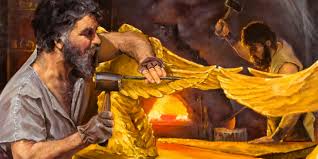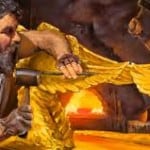The artisans who made the Mishkan and its equipment
“They shall make for Me a sanctuary, and I shall dwell among them.”1
G d asked the Jewish people to build the Mishkan, a portable sanctuary to house His presence, which would accompany them on their travels through the desert. The detailed description of the Mishkan included numerous fittings and furnishings that required a skilled touch, from the gold-covered holy ark to the embroidered curtains that formed the roof of the Mishkan.
Many accomplished men and women contributed their talents to the project, headed by two individuals who were appointed by G d Himself.
We read in the Parshah of Ki Tisa as follows:
G d spoke to Moses, saying: “See, I have called by name Betzalel, son of Uri, son of Hur, of the tribe of Judah. I have filled him with a divine spirit, with wisdom, understanding and knowledge, and with [talent for] all types of craftsmanship: to devise plans; to work with gold, silver and copper, and in cutting stones to be set, and in carving wood; and to do all types of creative work. Furthermore, I have assigned along with him Aholiav, son of Achisamach, of the tribe of Dan; and in the heart of every wise person I have placed wisdom. They shall execute everything that I have commanded you . . .”2
Who were these two craftsmen who merited to be mentioned in the Torah by name?
Betzalel: A Family Legacy of Self-Sacrifice
The chief architect of the Mishkan and the one responsible for the entire project was Betzalel, the scion of a highly distinguished family.
His great-grandmother was Miriam, sister of Aaron and Moses.3 When Pharaoh ordered the chief midwives of the Jewish people—Miriam and her mother Yocheved4—to kill the baby boys, they courageously refused, and indeed redoubled their efforts to help the mothers and their babies by supplying them with food and other necessities. One reward for Miriam’s selfless acts was that Betzalel, the brilliant architect of the Mishkan, was her descendant.5
Miriam’s son and Betzalel’s grandfather was Hur. The Midrash describes how he, too, bravely stood up for righteousness—this time against the people who wished to make a golden calf and worship it—and was tragically killed.6 G d honored his heroism by repeatedly singling out the name of his grandson Betzalel from among all of the Mishkan’s artisans.
A Multi-Talented Craftsman with Divine Wisdom
Betzalel was no ordinary artisan. His talent was divinely inspired—he could intuitively understand G d’s wishes. This ability was signified by his very name, as described in the following Talmudic narrative:
G d told Moses, “Go and tell Betzalel to make for Me a Mishkan, with an ark and other furniture.” Moses, though, reversed the order and said to Betzalel, “Make an ark, furniture and a Mishkan.” To which Betzalel replied, “Our teacher Moses! The usual practice is to build a house and then bring in the furniture. You are telling me to make an ark, furniture, and [then] a Mishkan—where will I be placing the furniture that I will be building? Perhaps G d instructed you this way: make a Mishkan, [then] an ark and other furniture?”
Said Moses to him: “Were you betzel E l, in the shadow of G d, that you know this? This is indeed how G d instructed me!”7
A similar episode occurred when G d instructed Moses to make the golden menorah:
When G d told Moses, “Make a menorah of pure gold,” Moses said: “How should it be made?” and was told that it should be hammered out of a solid block. Nonetheless Moses found it difficult to understand, and when he came down [from Mount Sinai] he forgot how to make it. He went back up and said, “My master, how should it be made?” to which G d replied, “It should be hammered out of a solid block.” Again Moses found it difficult to comprehend, and when he came down from the mountain he forgot the details.
He went back up yet again and said, “My master! I have forgotten it.” G d showed him the process again, but he still found it difficult. G d then said, “Watch and do the same,” and took a menorah of fire and showed him how to make it. Yet Moses still couldn’t understand.
So, G d said to him, “Go to Betzalel; he can make it.” And indeed, Moses asked Betzalel, and he immediately was able to make it. Moses was astonished: “G d showed it to me several times, yet I couldn’t understand how to make it; yet you, who never saw it, were able to make it on your own? Betzalel, you must have been standing betzel E l, in the shadow of G d, when He showed me how to make the menorah.”8
Ramban (Nachmanides), one of the major commentators on the Torah, notes that Betzalel’s abilities were in themselves a miracle, since during the centuries of the Jews’ stay in Egypt they had no access to precious metals such as gold, silver and copper. Thus, the fact that Betzalel knew how to work these metals and craft utensils from them was wholly unexpected.9
Betzalel’s Appointment
Even someone appointed by the highest authority, G d Himself, needs to be confirmed and accepted by the public. The Talmud derives this from the phrase, “See, G d has called Betzalel by name,”10 and describes the process as follows:
G d asked Moses: “Do you consider Betzalel worthy?” He replied, “Master of the world! If he is worthy in Your estimation, then how much more so in mine.” G d told him, “Nonetheless, go and clear it with [the people] as well.” So Moses went and asked the Jewish people: “Do you consider Betzalel worthy?” and they replied, “If he is worthy in G d’s estimation and in yours, then certainly he is worthy in our estimation too.”11
On the other hand, the Midrash describes how some of the people originally criticized the choice of Betzalel:
When Moses came down, he relayed to the Jewish people the details of how the Mishkan, its beams, the altar and the table were to be built. They asked, “Who will make all of these?” He replied, “Betzalel.” The people then started criticizing Moses, saying: “G d didn’t tell Moses to have Betzalel be the architect of the Mishkan; Moses picked him himself, because Betzalel is his relative . . .” To which Moses replied, “I did nothing on my own initiative; it was G d who told me to appoint Betzalel.”
Eventually, though, even the naysayers were reconciled and found Betzalel’s work to be to their satisfaction.
Aholiav, Son of Achisamach
Not much detail about Aholiav is given in the midrashim. We know that he was from the tribe of Dan, and that in certain respects his talents were equal to Betzalel’s, which is why he is specifically mentioned in the Torah, unlike the many other men and women who worked on the Mishkan and whose names are not given.
Centuries later, another scion of Dan played a leading role in the construction of the First Temple.12 The Talmud cites this as evidence that this tribe preserved their artistic tradition throughout that period.13
A Unique Pair
Betzalel, as we said above, descended from an aristocratic family; Aholiav, by contrast, was from the tribe of Dan—a less prestigious tribe, since they descended from Jacob’s handmaiden Bilhah. The Torah mentions Betzalel and Aholiav together, to demonstrate that to G d, both were on an equal level.14
The Zohar15 explains that Betzalel represents the Kabbalistic “right side” (kindness, benevolence), while Aholiav represents the “left side” (severity, strictness). They were able, then, to act in concert to build not just the Mishkan’s physical structure, but also its spiritual plane.
Don’t Forget the Least of the Tribes
There is an interesting connection between our daily prayers and the construction of the Mishkan. The Jerusalem Talmud states that the number of blessings in the Amidah prayer, 18,16 corresponds to the number of times in the Torah portions of Vayak’hel and Pekudei that G d’s commandment (tzivah) is mentioned. But a careful count yields 19 such words! However, the Talmud states that the first one does not count because it is mentioned before Aholiav’s name is introduced.17
Without Aholiav, there is no mitzvah.
The Lubavitcher Rebbe draws a powerful lesson from this: Before a person is ready to pray, he or she must reach a state where he feels a connection to every Jew, even the “least of the tribes.” Only when Betzalel and Aholiav work in unity can we forge a connection with G d.18
Footnotes
1.Exodus 25:8.
2.Exodus 31:1–6.
3.See Talmud, Sotah 11b.
4.Ibid.
5.Shemot Rabbah 48:4.
6.Ibid. 11:10; Tanchuma, Vayakhel 4.
7.Talmud, Berachot 55a.
8.Bamidbar Rabbah 15:10.
9.Commentary to Exodus 31:2.
10.Exodus 35:30.
11.Talmud, Berachot 55a.
12.II Chronicles 2:13. See also I Kings 7:13–14.
13.Talmud, Erachin 16b.
14.Rashi on Exodus 35:34.
15.Zohar 2:220b, 222a, et al.
16.A nineteenth blessing was added at a later date.
17.Jerusalem Talmud, Berachot 4:3.
18.Talk on Shabbat Parshat Vayak’hel-Pekudei 1958.

